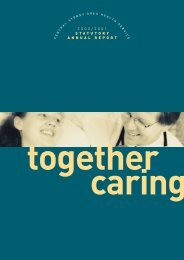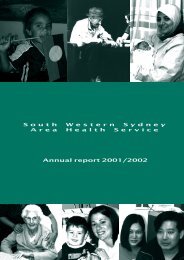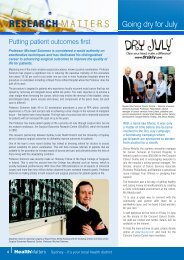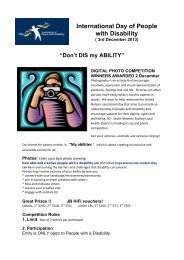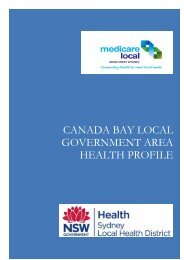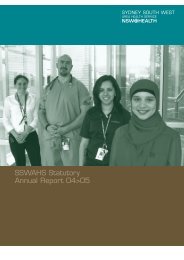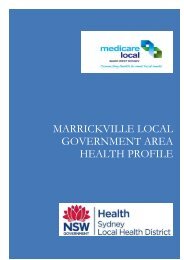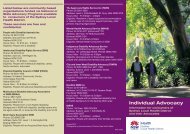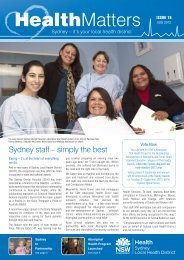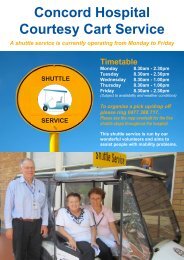frozen shoulder
frozen shoulder
frozen shoulder
Create successful ePaper yourself
Turn your PDF publications into a flip-book with our unique Google optimized e-Paper software.
Dr Doron SherMB.BS. MBiomedE, FRACS(Orth)Knee, Shoulder, Elbow SurgeryPATIENT NOTES - FROZEN SHOULDERA <strong>frozen</strong> <strong>shoulder</strong> (ADHESIVE CAPSULITIS) is a common condition seen in about 3% of the population. Itgenerally occurs in people over the age of 40 years and is seen far more often in women than in men. Itcommonly occurs in Diabetics and people with Thyroid disease.The cause of this condition is unknown. It generally occurs spontaneously without any trauma, but can alsooccur after a significant traumatic event such as a fall, fracture or dislocation. The condition is also seen notinfrequently after heart surgery, breast surgery or neurosurgery.This condition causes <strong>shoulder</strong> stiffness (hence <strong>frozen</strong> <strong>shoulder</strong>) as well as pain with movements of the arm andparticularly pain at night. The lining of the <strong>shoulder</strong> (the capsule) becomes inflamed and contracted and thecondition occurs in both <strong>shoulder</strong>s in 10% of people. Once the condition settles it rarely recurs.As a general rule the condition is SELF LIMITING. This means that the condition generally gets better by itself.It can take up to two years for the condition to resolve and the reasons for this are not known.There are 3 distinct phases to a <strong>frozen</strong> <strong>shoulder</strong>:1. FREEZING PHASE or painful phase that lasts 2 to 9 months (sometimes even longer in diabetics).Patients get pain at rest, with activity and also pain at night. There is significant restriction of motion.2. FROZEN PHASE this is the progressive stiffness phase that lasts 3 to 12 months. Pain occurs only atthe extremes of movement but the <strong>shoulder</strong> remains stiff.3. THAWING PHASE this is the resolution phase where movements improve over a 12 to 24 monthperiod. This phase is not typically painful.In 80% of patients the pain resolves completely but some people are left with a small and permanent restrictionof range of motion. This loss of motion hardly ever worries the patient.Arthritis of the <strong>shoulder</strong> has similar symptoms to a <strong>frozen</strong> <strong>shoulder</strong> initially and needs to be excluded byobtaining an xray of the <strong>shoulder</strong>. In rare instances the arthritis does not show up on xray (especially in the earlyphase of arthritis) and one can only make the correct diagnosis after a year or two. Typically this is when thecondition does not resolve and another xray is taken, now showing evidence of arthritis. Ultrasoundexaminations are not usually helpful.
TREATMENTThe most important aspect of the treatment is to understand that this is a condition that should get betterby itself. The mainstay of treatment is to use the arm as much as possible (within the limits of your discomfort).You should not immobilise the arm or stop using it as this will cause the condition to deteriorate. You mayrequire regular pain killers and perhaps something to help you sleep, for which you should see your familydoctor. I also recommend regular antiinflammatory tablets (if you can tolerate them).Steroid injections into the joint are an option but rarely work. At best they tend to give short lived and partialrelief of symptoms (and have a small risk of introducing an infection into the joint). If you elect to have theinjections then these should be given by a Radiologist and using a sterile technique. I only recommend theseinjections if you have unremitting pain as they do have risks and side effects.You need to see a physiotherapist to be taught a series of <strong>shoulder</strong> exercises. These exercises can be painful andshould not include stretching exercises. The aim of the exercises is to keep the <strong>shoulder</strong> mobile and avoidfurther stiffness. The exercises are not designed to improve the range of your movement. It is onlynecessary to see the physiotherapist on a few occasions and then you should perform the exercises yourself (Isuggest 4 times a day, for 5 minutes each time).There is a relatively new technique available called Hydrodistention, where a Radiologist “blows up” ordistends the <strong>shoulder</strong> joint with fluid, and breaks down the contractures. There have been isolated reports ofsuccess with this technique leading to a more rapid recovery from the condition but there has not been ascientific study to determine whether the long term results are any better than the “wait and see” approach.There are risks of the procedure (such as infection). You are free to try this technique and you will require areferral from your GP or one of our sports medicine physicians to the Radiologist. If you elect to try this courseof management please make sure you discuss the risks and complications with the doctor performing theprocedure. You will require supervised exercises for several months after the injection.My advice, in most cases, is that you should learn to live with the condition for 12 to 24 months -(providing the pain in tolerable and you can cope with the activities of daily living).If you have not reached the Second “FROZEN” phase within 9 to 12 months, then there is a reasonable case toperform a Manipulation under Anaesthetic and an injection of cortisone. This requires an admission to hospitalfor a few hours and a general anaesthetic. We manipulate the <strong>shoulder</strong> and inject cortisone under sterileconditions. Following the procedure you will require 3 to 4 months of physiotherapy. The success rate of theprocedure is 70% but there is a 2% chance of breaking your arm during the manipulation. The other risks arethose of the anaesthetic and the possibility of introducing an infection into the joint with the injection.In the unlikely event that the condition becomes chronic (which is quite rare) I will discuss with you a procedurecalled an Arthroscopic Capsular Release which involves an overnight stay in hospital. Using an arthroscope(television camera to look into the joint) and 3 small skin cuts, it is possible to release the contracted tissue. Thisis a rather painful procedure that requires aggressive physiotherapy following surgery and takes 6 months torecover fully from. The success rate of the surgery is about 70%.There are a number of patients who cannot afford to have a stiff <strong>shoulder</strong> for a prolonged period of time (forwork or social reasons). Should that be the case then they may wish to consider having a Manipulation underAnaesthetic early in the course of the disease (and accept the risk of having a complication).Finally, I would recommend that all patients return to their family doctor to have him or her manage the paincontrol and monitor the physiotherapy and exercises. Every patient with this condition should have a blood testto exclude diabetes and those patients with diabetes need to ensure their diabetic control is as good as possible.If the condition does not improve in the timeframe indicated above please return to see me.If after reading this handout you have any questions please ring the office and leave a message for me to ring you back.2008



